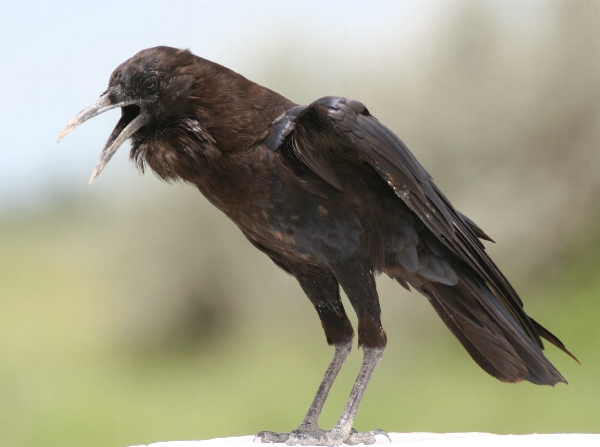| 새로운 사진 | 신문속의 동물소식 | 신기한 동물이야기 | 동물의 소리 | 동물동화상 | 사진 올리기 | 사진 저작권 | English |
|---|
| 재미있는 동물사진 | 괴수/괴어/엽기 동물사진 | 동물이름사전 | 동물목록 | 바깥고리 | 창고입구 | 똑똑누리집 |
|---|
| 이미지 정보 | Original File Name: Black or Cape Crow (Corvus capensis).jpg Resolution: 600x447 File Size: 155956 Bytes Upload Time: 2007:12:03 11:02:01 | |
| 올린이 | 이름 (메일주소): Unknown | |
| 사진 제목 | Cape Crow (Corvus capensis) - Wiki | |
 |
| Email : 카드 | 올린이 | 운영자 사진삭제 정보수정 Admin |
| 설명 | Cape Crow (Corvus capensis) - Wiki
Cape Crow
The Cape Crow or Black Crow (Corvus capensis) is slightly larger (48-50 cm in length) than the Carrion Crow and is completely black with a slight gloss of purple in the feathers. It has proportionately longer legs, wings and tail too and has a much longer, slimmer bill that seems to be designed for probing into the ground for invertebrates. The head feathers have a coppery-purple gloss and the throat feathers are quite long and fluffed out in some calls and displays. Distribution and habitat This species occurs in two large separate regions of the African continent. One form ranges from the Cape at the southern tip of Africa up to southern Angola and across to the east coast of Mozambique. The other population occurs in a large area from Sudan, Ethiopia and Kenya in central east Africa. The more northern population is on average slightly smaller than the southern. It inhabits open grassland, moorland, agricultural areas with some trees or woodland in the vicinity for nesting. It seems to thrive especially in agricultural areas. Behaviour Diet As far as feeding is concerned, it seems to fill the same niche as the Rook in Europe and Asia as it takes grain and other seeds, invertebrates which it digs for with powerful downward stabs of its long bill. It opens Maize before they are fully ripe, bulbs and fleshy roots of certain plants, frogs and small reptiles, fruits and berries. It takes the eggs and chicks of ground nesting birds and has been known to kill birds of up to a pound in weight (especially domestic poultry). It turns over the droppings of mammals for insects. Nesting Nesting is always in trees, usually near the top. It has been known to nest in shrubs but much less frequently. There are usually 3-4 eggs incubated over 18-19 days and fledged by around 38 days. Usually only 3 nestling's ever surviving. Voice The voice is describes as a "krrah.....krrah.....krrah" or a quicker "kah-kah-kah". It also make very loud, liquid bubbling sounds that carry quite a distance and also gives throaty chuckles. There is evidence that vocal mimicry is practiced too. http://en.wikipedia.org/wiki/Cape_Crow
| |||
| 저작권 정보 | 사진의 저작권은 원저작자에게 있습니다. 동물그림창고는 동물관련 사진을 전시할 수 있는 공간만을 제공합니다.사진을 사용하고자 할 경우에는 저작권자와 협의하시기 바랍니다. |
|
|
|
| |||||||
| CopyLeft © since 1995, 동물그림창고. All rights may be reserved. | ||||||||
Stats